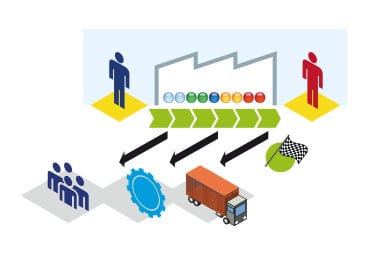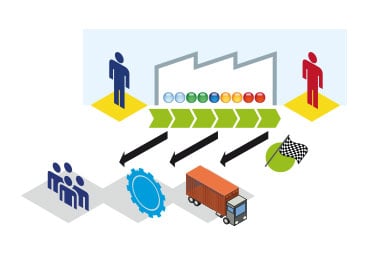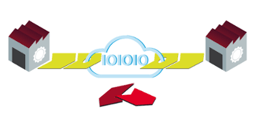How to Get the Most from Your Advanced Analytics
Brian Hoey - February 08, 2018

 Although automotive manufacturers have been hearing for years that Big Data is the next big thing, studies often show that executives, not just in automotive but across many different industries, fear that their organizations aren’t ready to take advantage of the new advancements in analytics. Big Data analytics can and will be a huge value-added proposition for companies hoping to stay competitive in the world of Industry 4.0, but it’s true that reaping the benefits of new technological insights often requires significant changes in workflows and IT infrastructure. Luckily, these changes are often not as daunting as they first appear. Here are a few suggestions for getting the most out of your advanced analytics.
Although automotive manufacturers have been hearing for years that Big Data is the next big thing, studies often show that executives, not just in automotive but across many different industries, fear that their organizations aren’t ready to take advantage of the new advancements in analytics. Big Data analytics can and will be a huge value-added proposition for companies hoping to stay competitive in the world of Industry 4.0, but it’s true that reaping the benefits of new technological insights often requires significant changes in workflows and IT infrastructure. Luckily, these changes are often not as daunting as they first appear. Here are a few suggestions for getting the most out of your advanced analytics.
Data Integration
Dig Data analytics have the ability to offer insights into a given manufacturer's production processes, demand capacity, and transport routing, that would simply be impossible for a pen and ink planner. In order to gain those insights, however, companies must collect and provide large quantities of usable data. In this way, we can see Postmodern ERP principles as being crucial to the analytics process. Postmodern ERP can improve your data collection in a few ways:
- Fostering digitization through connected IT solutions
- Creating interoperable systems that connect disparate planning and operations functions, leading to increased visibility and data centralization.
- Directing IT purchases away from “best in breed” and towards integrated digital workflows
By promoting digitization and end-to-end (E2E) visibility, Postmodern ERP can ensure that the quality, quantity, and accessibility of a given business’ data are all substantially improved. When information siloes can be removed and other impediments to transparency done away with, advanced analytics can be put to work in a holistic manner that accounts for all variables in variant-rich supply chain. Not only that, but Postmodern ERP can help to drive the integration of real-time data into planning and production processes, pioneering new areas in which advanced analytics can be used to create insights, or even automate processes.
Lean Manufacturing
Once they’re connected to mission critical data through a company’s IT infrastructure, advanced analytics solutions will generally boast two different areas of analysis: predictive and prescriptive. Predictive analytics refer to data-driven forecasts and real-time models that help manufacturers predict future demand and oncoming disruptions; prescriptive analytics analyze workflows and production processes in order to uncover areas of waste or inefficiency. In order to maximize the value of these types of analysis, it can be helpful to begin driving towards a lean supply chain.
Now, you may be thinking, “isn't the whole point of these software solutions to help me develop lean manufaturing processes?” Of course, the short answer is “yes,” but lean supply chain management is one area where a little effort goes a long way towards maximizing the added value of your analytics. As waste and redundancies are cut out of your value stream and your workflows become more optimized, the overall quality of your predictive analytics will improve. With fewer factors to take into account, you can benefit from more reliable forecasts, which will in turn improve your prescriptive analytics, as they will be able to offer actionable insights with a lower degree of uncertainty and risk. These insights, in turn, can help you to further optimize your value chain, which will mean better predictive analytics. Ultimately, these two functions can work hand in hand to create a continuing cycle of optimized processes and improved demand planning, and any efforts your company makes toward crafting a lean supply chain stand to be amplified within this cycle.
Defining Your Roadmap
Postmodern ERP and lean supply chain management, both value added propositions in their own rights, can help manufacturers pave the way for a robust implementation of advanced analytics solutions. What they can’t do, however, is turn Big Data and analytics into a panacea for all supply stream issues. Getting the most out of your data is not just a matter of installing new software and waiting for the money to roll in—which is why it’s so crucial to develop a clear roadmap for how your analytics can best be utilized. Planners should ask themselves a few questions when developing such a road map:
- How can I avoid an overwhelming mass of disorganized data? Can I instead implement specific data-driven tools for specific business functions (i.e. a real-time quote generator to help manage pricing based on demand; or live warehouse and freight monitoring to aid transport logistics)?
- Where can Big Data be used to automate processes (i.e. inventory tracking or replenishments)? In what areas can analytics cut through complex, variant rich processes?
- What specific business goals do I want my analytics to address? What hypotheses do I have about my supply chain workflows, and can I test them on digitized predictive models of my operations?
- Will my proposed implementation increase point-to-point visibility within my value stream (e.g. by adding real-time or other functionality)?
Once you’ve answered these questions, you should have a much clearer idea of the role that Big Data can play in your operations going forward. The result will be a competitive advantage not just over those whose supply chain management isn’t informed by analytics, but over those whose data solutions haven’t been properly integrated with their key performance indicators (KPIs).
LATEST POSTS
- Understand Circular Economy in The Manufacturing Industry
- How Can Industry 4.0 IT Integration Be Achieved Smoothly?
- The Significance of Order Sequencing in Discrete Manufacturing
- How to improve your Supply Chain Management: The Power of Control Towers
- Optimizing Human Resource Scheduling in Manufacturing: A Technological Approach



